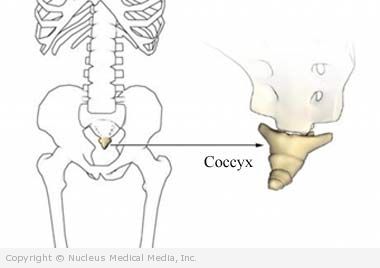(Tailbone Fracture; Broken Tailbone)
Coccyx Fracture – Definition
A coccyx fracture is a broken tailbone. The coccyx is the lowest part of the backbone or spine. It is small, triangular in shape, and consists of four fused vertebra, or spine bones. Normally, it has a little bit of movement and curves gently from the end of the spine into the pelvis.
Coccyx Fracture – Causes
Causes of coccyx fracture include:
- Falling on the buttocks — Skating and other activities that lead to falls in the seated position often contribute
- During birth — Newborns can break their coccyx going through the birth canal
Coccyx Fracture – Risk Factors
Factors that increase your chance of a coccyx fracture include:
- Sex: female (A woman’s broader pelvis leaves the coccyx more exposed to injury)
- Advanced age
- Reduced muscle mass, which may lead to poor balance and increased risk of falls
- Osteoporosis
- Poor nutrition, especially inadequate calcium and vitamin D
- Certain congenital bone conditions
- Participating in certain activities, such as skating
- Violence
Coccyx Fracture – Symptoms
Symptoms may include:
- Pain that increases with sitting or getting up from a chair
- Pain that increases during a bowel movement
- Tenderness over the tailbone
Coccyx Fracture – Diagnosis
The doctor will ask about your symptoms and how the injury occurred. A physical exam will be done. The exam may include a rectal exam. During a rectal exam, the doctor places a lubricated, gloved finger into the rectum and feels for any abnormalities. If the coccyx is fractured, your doctor may feel abnormal movement of the coccyx, and you will experience pain. X-rays may or may not be required.
Coccyx Fracture – Treatment
The goal is to manage pain until the bone can heal. Doctors usually do not try to correct a bad alignment. Muscles in the area are powerful and can pull the coccyx back out of position. The location of the coccyx and the number of muscles attached to it make immobilization very difficult.
The area may remain painful for a long period of time, even after the fracture has healed. You may be advised to stay in bed for a day or two, or move only as comfort allows. Steroid injections or surgery may be considered if severe pain persists. Surgery for a painful coccyx fracture is very rare and not very successful. Usually pain gradually disappears.
Pain Relief
You may be given medication to ease the pain. To reduce discomfort during bowel movements:
- Drink plenty of fluids and eat a diet rich in fruits, vegetables, and whole grains.
- Stool softeners may help decrease straining during bowel movements.
- Sitz baths can help relieve muscle spasms. A sitz bath involves soaking the anal area in warm tap water for 10-20 minutes.
Sitting can be very uncomfortable after a coccyx fracture. Suggestions to make sitting less painful include:
- Sit on an air cushion or doughnut pad.
- Alternate between sitting on one side of the buttock or the other.
- Avoid sitting on very soft surfaces. Sinking into a soft chair sometimes increases the pressure on the coccyx.
- Slouch to move your weight forward and off the coccyx. Note: This advice holds only until you are well enough to sit properly again.
- Sit on a telephone book, with the area of the coccyx hanging off the posterior portion of the phone book.
Surgery
If pain continues and causes disability, a coccygectomy might be recommended. During this procedure, the doctor removes the coccyx. It is not a common procedure and the success rate is not what one would hope for.
If you are diagnosed with a coccyx fracture, follow your doctor’s instructions.
Coccyx Fracture – Prevention
To help prevent a coccyx fracture:
- Eat a diet rich in calcium and vitamin D.
- Do weight-bearing exercises to build strong bones.
- Build strong muscles to prevent falls.

